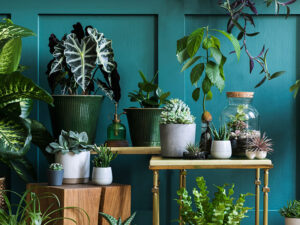Whether you’re a brand-new plant mom or have been raising plant babies for years, there’s one houseplant you need to add to your wishlist: Rhaphidophora tetrasperma. Rhaphidophora can be hard to find in nature and once wasn’t too easy to find in nurseries or plant shops.
That’s changed in recent years, and you can now easily track down Rhaphidophora at your local nursery. If you have other plant mom friends, they might be able to give you a cutting of one of theirs.
If you’re ready to add Rhaphidophora tetrasperma to your plant family, here’s everything you need to know to make sure your plant baby grows and thrives in your home.
What is Rhaphidophora Tetrasperma?
Rhaphidophora tetrasperma is a member of the aroid family, also known as the Araceae family. Aroids have a few distinguishing features in common.
Plants in the family typically produce an inflorescence, or flower cluster, that consists of a rod-shaped spadix and a leaf-like spathe. Examples of aroid flowers you might have seen include Peace Lily and Anthurium.
Although the flowers might be common in nature, most aroids grown as houseplants don’t live in conditions that lead to flower production. So, don’t expect your Rhaphidophora to bloom.
Many members of the aroid family are tropical plants, but some varieties grow all over the world, on every continent except for Antarctica. Rhaphidophora grows natively in Southern Thailand and Malaysia.
If Rhaphidophora looks familiar to you, that’s probably for good reason. The plant produces leaves that are similar in shape and pattern to Monstera deliciosa (another member of the aroid family). Its wide, flat leaves are fenestrated, meaning they develop openings as the plant grows.
Rhaphidophora has smaller leaves Monstera deliciosa, though. Because Rhaphidophora looks similar to Monstera, a nickname for it is “mini monstera.”
Rhaphidophora is also often confused with philodendron, which is also part of the aroid family. Another nickname for the plant is Philodendron piccolo. If you’ve found a plant labeled Philodendron piccolo, Philodendron Ginny or mini monstera, you’ve found Rhaphidophora tetrasperma.

Rhaphidophora Tetrasperma Care
When you first bring your Rhaphidophora baby home, it’s likely going to be on the small side. But with the right conditions and a little attention from you, your little one will soon grow to a six-foot-plus vine!
Depending on your preference, you can let the plant trail down the sides of its planter, or you can train it to vine up a moss pole. You can also train the plant to grow up a trellis or totem.
Light Needs
Rhaphidophora prefers bright indirect light. Putting it near an eastern or northern facing window can be ideal. The plant will get some morning light, but not too much.
If you can, avoid putting it by a southern or western facing window. Direct light is too much for this little guy. Intense sunlight will burn the plant’s leaves. Remember, Rhaphidophora usually lives in the understory of forests, so any light it gets in nature will be dappled and filtered by the tree leaves above it.
If your house is dark or your windows small, you can give Rhaphidophora Tetrasperma the light it needs by placing it under a grow light.
Soil and Fertilizer Needs
Rhaphidophora doesn’t like to have its feet (roots) get too wet. A well-draining potting soil is ideal for the plant. A potting soil made from peat moss and orchid bark or perlite is perfect for Rhaphidophora.
Be careful when feeding Rhaphidophora. Fertilize when the plant is actively growing, using a high-nitrogen or balanced fertilizer. You don’t need to fertilize outside the growing season, usually during the colder months of the year.
It’s better to err on the side of too little than too much fertilizer, as Rhaphidophora can be sensitive. Its roots can burn if you feed it too much.
Water and Humidity Needs
Rhaphidophora likes water and will grow more vigorously if you keep up with watering. Just don’t overdo it, though. Too much water can lead to root rot and an unhappy plant.
It’s best to let the soil dry out at least one inch deep before watering again. When you do give the plant a drink, make sure you thoroughly saturate the root ball. Water should run out the bottom of the pot.
The plant will do fine in regular home humidity levels (around 40%). But if you can give it more, it will love it. One way to raise the humidity around your Rhaphidophora is to position it near other plants.
Pot and Support Needs
Pick a pot for your Rhaphidophora that has a drainage hole, so the water can flow away from the soil. You can use a moss pole or totem to train the plant to grow upwards.
Rhaphidophora produces aerial roots along the length of its vines. Those roots will grab onto a pole or string, giving the plant support.
Rhaphidophora Tetrasperma Problems
Rhaphidophora is usually easy-going and trouble-free, but like all houseplants, it can struggle when conditions aren’t ideal. Keep your eye out for some common Rhaphidophora problems.

Leaf Problems
Yellow leaves can be a sign that your Rhaphidophora is under stress. Usually, too much or too little water is to blame. If the soil is too dry, give your plant a drink and get in the habit of checking the soil regularly. If you’ve been giving Rhaphidophora too much water, cut back and wait for the soil to dry out a little.
Root Problems
Too much water can also lead to root problems. The Rhaphidophora Tetrasperma can develop a fungal infection on its roots when the soil is soggy and damp. Along with cutting back on water, it’s a good idea to make sure the soil you’re using drains well. Mixing in perlite or orchid bark can improve drainage.
Pest Problems
Yellow leaves can also be a sign of a pest problem, namely a spider mite problem. Spider mites suck the sap from the plant’s leaves, causing them to yellow and drop off. If you see signs of spider mite damage, act quickly. Mixing a few drops of dish soap or neem oil with water and spritzing the plant with the mixture should kill off the pests.
Propagating Rhaphidophora Tetrasperma
When your baby has gotten big enough to make its own babies, it’s a great feeling. You can propagate Rhaphidophora by cutting a length of the vine just below a leaf node. Remove most of the leaves from the cut vine, then place in water or potting mix. New roots should grow within a couple of weeks.
Variegated Rhaphidophora Tetrasperma
Variegated Rhaphidophora tetrasperma has leaves that are at least two different colors. While the planting caring requirements are the same as for “regular” Rhaphidophora tetrasperma, variegated varieties are much rarer and tend to cost a lot more. One person reportedly spent nearly $20,000 on a variegated plant!
If you want the joys of caring for Rhaphidophora tetrasperma without breaking the bank (a rare white variegated Rhaphidophora Tetrasperma sold for $19,000 in New Zealand!), get your hands on a plant with solid green leaves. Its fast growth rate and long life make it a great addition to your plant family.
Emily Sprinkle, also known as Emma Loggins, is a designer, marketer, blogger, and speaker. She is the Editor-In-Chief for Women's Business Daily where she pulls from her experience as the CEO and Director of Strategy for Excite Creative Studios, where she specializes in web development, UI/UX design, social media marketing, and overall strategy for her clients.
Emily has also written for CNN, Autotrader, The Guardian, and is also the Editor-In-Chief for the geek lifestyle site FanBolt.com
- Emma Loggins Sprinklehttps://www.womensbusinessdaily.com/author/emma-loggins/
- Emma Loggins Sprinklehttps://www.womensbusinessdaily.com/author/emma-loggins/
- Emma Loggins Sprinklehttps://www.womensbusinessdaily.com/author/emma-loggins/
- Emma Loggins Sprinklehttps://www.womensbusinessdaily.com/author/emma-loggins/







